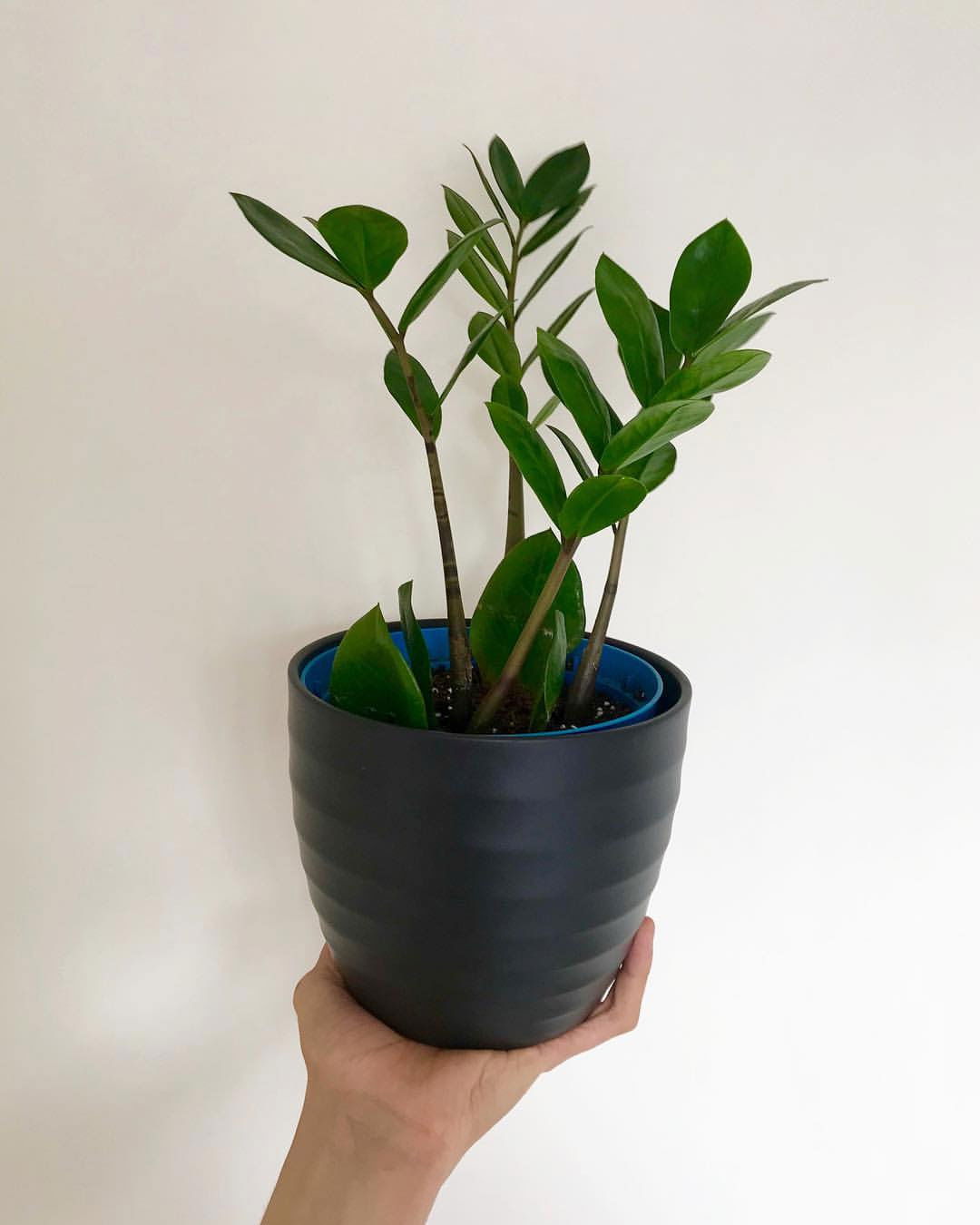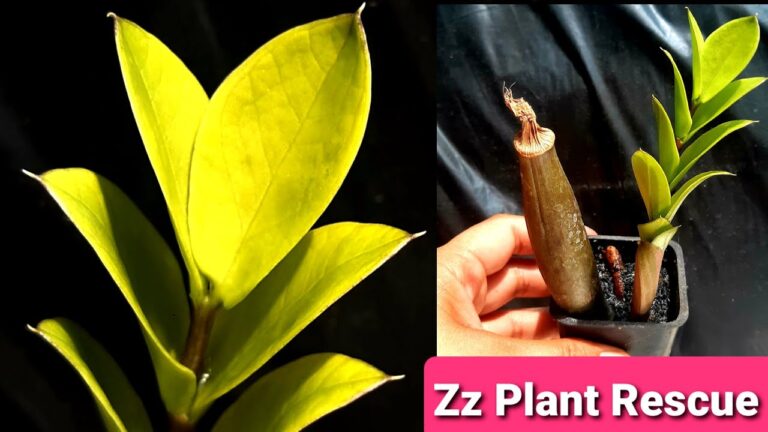Knowing When to Give Your ZZ Plant a New Home
Making sure your ZZ plant gets a change of scenery (or pot, really) is a game-changer for keeping it happy and growing. So, how do you know when it’s time to play musical pots? Let’s take a look.
Root Appearance
Imagine it: roots peeking through drainage holes, swirling around like they’re in a root race. If you spot this, it’s like your plant is saying, “Hey, I’m squished!” This twisted root party means your ZZ’s grown too cozy in its current home. And when roots tie themselves in knots, your plant can’t drink up its vitamins and stay hydrated, which puts the brakes on growth. Give those roots some breathing space for better health overall.
Pot Condition
Look at your pot like you would a pair of shoes that are too small. If it’s chipped and cramped, your ZZ plant deserves an upgrade. Pick a pot just a tad roomier—like going from snug shoes to ones you can wiggle your toes in. This helps roots stretch without turning the soil into a swamp, which could invite rot. Too big a pot just means water ends up hanging around longer than it should, and that’s no good for roots either.
| Pot Conditions | Your Move |
|---|---|
| Pot’s beat up or has battle scars | Switch it out |
| Roots are trying to escape | Go up a size in pots |
| Soil’s all packed down and stubborn | Fresh soil, stat |
Plant Health Signals
Keep an eye out for little cries for help from your plant. Are the leaves throwing in the towel and turning yellow? Is growth slower than you waiting in line for coffee? A cramped pot might be the villain here. A ZIP plant that’s root-bound and can’t suck up snacks (nutrients) or drinks (water) properly is easy to spot — so don’t wait too long to do your plant a favor and freshen things up.
| Health Symptoms | What’s Going Wrong? |
|---|---|
| Yellowing leaves | Needs more grub, too tangled up |
| Not growing | Roots snug as a bug, but not in a good way |
| Practically bursting out of the pot | Needs more root room |
Getting these hints will let you know when it’s prime time to get your ZZ plant a bigger home. For more straight-up plant advice, check out our guides on dealing with rot in your ZZ plant’s roots, feeding your ZZ plant right, and more on keeping your ZZ looking sharp indoors.
The Repotting Process
Getting your ZZ plant into a new pot is key to keeping it happy and growing strong. Here’s your go-to guide on when and how to do it right.
Timing for Repotting
Timing is everything. I’ve noticed that it’s best to move your ZZ into a new home during its growth spurt in the spring or when summer starts knocking. This way, the plant has plenty of time to bounce back and settle in before winter rolls around. Want more on plant timing? Peek at Lively Root’s take on how to repot a ZZ plant.
Soil Selection
Picking out soil seems like a tiny detail, but it’s a biggie. For ZZ plants, you want soil that lets the water breeze through—think perlite, pumice, or wood chips. Personally, I like mixing in a bit of cactus or succulent soil to help with drainage. This setup keeps roots healthy and free from rot. Curious about soil? Lively Root’s got a decent guide on proper soil selection for ZZ plants.
| Soil Type | Goodies Inside | Perks |
|---|---|---|
| Well-drained soil | Perlite, Pumice, Wood Chips | Stops water from pooling, avoids root rot |
| Cacti/Succulent mix | Sand, Grit, Pebbles | Boosts air and drainage, just what ZZ plants need |
Container Size
Pot size isn’t just about looks. I always go for a pot that’s 1-2 inches bigger than the last one. It gives roots room to grow but doesn’t drown the plant in water. Big pots can be too cozy, holding onto water and choking your plant. More deets on pot size? They’re over on Lively Root’s page on repotting ZZ plants.
For all things ZZ plant care, like zz plant light and zz plant indoor care, we’ve got other articles to dig into. Nail the timing, soil pick, and pot just right, and watch your ZZ plant flourish in its new digs.
Care After Repotting
Watering Guidelines
Watering your ZZ plant might seem like a walk in the park, but it’s essential to do it right after repotting. Don’t drown the poor thing—wait until the top inch of soil feels dry before giving it another drink. Inserting your finger an inch into the soil is the easiest way to check.
| Watering Frequency | Soil Condition |
|---|---|
| Every 2-3 weeks | Top inch dry |
Peep at those drainage holes; make sure they’re not having a swimming pool party down there. If the dirt’s going Sahara desert on you faster than usual, it might be time to water. For more juicy details, browse our zz plant water requirements.
Lighting Requirements
Your leafy friend needs the right glow to stay perky post-move. Bright, indirect light is its jam, so keep it near a window but shielded from that harsh sun—don’t want those leaves to look like toast, do we? If yellow flags start waving from the leaves, your plant’s screaming, “Too much sun, buddy!” Check out why in zz plant leaves turning yellow.
| Light Condition | Placement |
|---|---|
| Bright Indirect Light | Near a window, but out of direct sunlight |
Need more scoop on the best light for your ZZ plant? Dive into zz plant light.
Nutrient Considerations
Post-repotting, it’s chow time with nutrients. In spring and early summer, it’s like opening a food truck. Use a balanced, water-soluble fertilizer once a month. Now, come winter, your plant wants Netflix and chill—no fertilizers allowed.
| Season | Fertilizing Frequency |
|---|---|
| Spring/Summer | Once a month |
| Fall/Winter | None |
Opt for a potting mix that says, “Water, you shall not pass!”— think cactus or succulent soil. Adding perlite or some coarse sand works wonders, making water drainage as smooth as a greased slide. For the curious, our zz plant potting soil guide is here to help.
Stick to these tips, and your ZZ plant will be living its best life after the big move. Keep an eye out for any changes, and for even more plant wisdom, our resources on zz plant indoor care and zz plant dying are at your service.
Benefits of Repotting ZZ Plants
Messing around with ZZ plants and putting them in a bigger home every now and then is crucial for keeping them happy and growing strong. Getting why this works helps me keep my ZZ plant looking sharp.
Keeping Roots Happy
By shifting things up, I can dodge usual root dramas like soggy roots and dirt that’s turned rock-solid, both of which mess with the roots’ job of gobbling up nutrients. Fresh soil, that drains well, keeps roots out of the water-logged muck, making them less likely to rot like an old peach (Lively Root). Check out the table below that shows root issues and how giving plants a new lease of life with fresh soil fixes them.
| Root Drama | How to Avoid the Drama |
|---|---|
| Dreaded Root Rot | Grab some fresh, draining soil |
| Rock-Solid Dirt | Loosen up, man |
| Drainage Woes | Better soil, better life |
Boosting Plant Mojo
Switching up pots gives plants room to stretch their legs (roots, really) and soak up the good stuff like a sponge. When I break apart the rhizomes, it’s like hitting reset, firing them up for a burst of new life. Plus, tossing out old soil and bringing in new dirt revives the plant so it’s not running on empty (Lively Root).
Checking the Roots for Trouble
When I’m repotting, it’s the perfect chance to eyeball the roots for any illness, like root rot, and chop off anything looking rough. This gets my ZZ plant on the road to recovery in cleaner digs (Lively Root). It’s also a time to boot out pests or patch up any plant sickness staring me in the face.
Getting the hang of these perks helps me nail the repotting process and take good care of my ZZ plant. To dive even more into ZZ plant nurturing, take a look at our bits on zz plant indoor care and zz plant potting soil.




